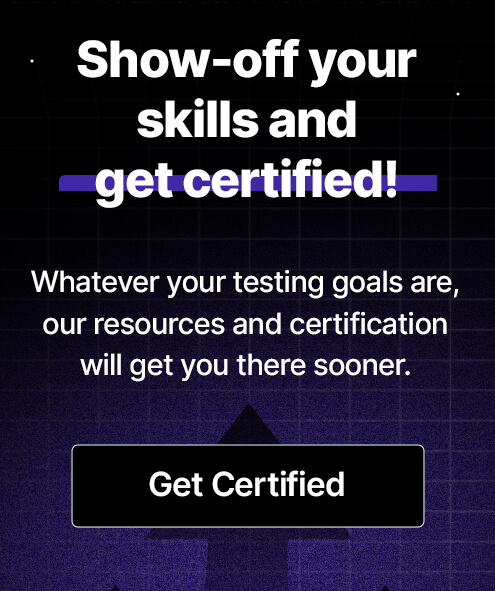What Is End to End Testing? Best Practices & Examples

Any organization would never release software that hasn't been tested first. But there are lots of ways to test software. A way is to try from beginning to end. Sometimes, it takes a lot of time and resources, but it might be the most important way. End-to-end tests can be automated, which is good news.
In our blog, we will explain what is end-to-end testing, along with its benefits after implementing it in the testing process. Test automation is useful for more than just saving time.
What is End-to-End Testing?
End-to-end testing is a way to test software that tests the entire program from the very beginning and how well it works with other applications. It checks the whole software for dependencies, data integrity, and how well it talks to other systems, databases, and interfaces to simulate a full production situation.
It checks the software system and batch and data processing from other systems upstream and downstream. This is where the name "End-to-End" comes from. End-to-end testing is usually done after System Testing and Functional Testing. It uses real production data and a test setup to make it feel like real life. Testing from end to end is also known as Chain Testing.
SUGGESTED READ - What is Unit Testing? 6 Best Practices to Do it Right
How do you Write End to End Tests?
Writing end-to-end tests involves several key steps to ensure they effectively simulate real-world user scenarios and interactions with the application. Here’s a general process on how to do end-to-end testing:
- Begin by reviewing the software requirements. Make sure you understand how the application works and how to use it.
- Set up the test environment to meet the hardware and program needs.
- Next, learn about the system and its parts. Draw attention to the answers.
- Now, describe the ways that these answers will be tested. Some of these are end-to-end testing tools.
- Then, use the defined testing standards to make the test cases.
- Run the test that was described. Also, do experimental testing to look into other areas not covered in the planned test.
- Finally, save the test results and look them over.
Importance of End-to-End Testing
End-to-end testing checks the flow of the whole system and boosts trust by finding problems and testing more subsystems. Today's software systems are complicated and linked to many smaller systems that might differ from today's systems. Any breakdown in a subsystem can bring the whole system down. Testing from beginning to end can avoid this big risk.
Types of End-to-End Testing
End-to-end testing encompasses various types to cover the full spectrum of application functionalities and user scenarios. Understanding these types helps in designing a comprehensive E2E testing process. Here's a look at some common types:
UI Testing
Focuses on testing the graphical interface to ensure it is functional, user-friendly, and responsive to different devices and screen sizes. This type checks the visual aspects, including layouts, buttons, text fields, and other interactive elements.
API Testing
Tests the application programming interfaces (APIs) to ensure they work as expected, facilitating smooth communication between different software components and services. This is crucial for verifying backend functionality and third-party integration.
Performance Testing
Evaluates the system's performance under various conditions, including load, stress, and scalability tests. This ensures the application remains stable and efficient even when handling high traffic or processing large amounts of data.
Security Testing
Identifies vulnerabilities in the application, protecting against threats like SQL injections, cross-site scripting, and data breaches. This type is essential for maintaining user trust and compliance with data protection regulations.
Compatibility Testing
Ensures the application works seamlessly across different browsers, operating systems, and devices, providing a consistent user experience regardless of the user's technology choice.
End-to-End Testing Example
To illustrate how end to end testing is applied in practice, consider an example of an e-commerce application. This example will guide you through a basic test scenario from a user's perspective, emphasizing the importance of a comprehensive End to end testing process.
Scenario: A user purchases a product from the website, going through the entire process from product selection to payment and order confirmation.
Steps:
- Home Page: The test begins with the user landing on the e-commerce home page, verifying that all elements load correctly, including images, product categories, and special offers.
- Product Selection: The user selects a product category and then chooses a specific product. The test checks if the product details page loads correctly, displaying the product image, description, price, and add-to-cart button.
- Add to Cart: The user adds the product to their shopping cart. The test verifies that the cart updates correctly with the selected product, including price and quantity.
- Checkout Process: The user proceeds to checkout, entering their shipping and payment information. This step tests the integration with external payment gateways and ensures that all forms validate user input correctly.
- Order Confirmation: After submitting the payment information, the user receives an order confirmation page and, ideally, an email confirmation. The test confirms that the order details are correct and that the system updates the inventory accordingly.
- User Account: Finally, the user checks their account to see the order history. This step verifies that the order is logged correctly and the user’s account displays up-to-date information.
This example showcases the end-to-end testing technique's ability to simulate a real user's interaction with the application, ensuring every process step works as intended.
Benefits of End to End Testing
End-to-end testing offers significant benefits, including ensuring application reliability and user satisfaction. It thoroughly validates the software's functionality and performance in real-world scenarios, identifies integration issues between components, and reduces the risk of defects in production. Additionally, it helps catch potential security vulnerabilities, ensuring the application is robust and secure upon release.
E2E Best Practices
To maximize the effectiveness of end-to-end testing, it's important to follow best practices that streamline the process and ensure comprehensive coverage. Here are some E2E best practices to consider:
Prioritize Test Scenarios
Identify and focus on the most critical paths that reflect common user behaviors. Not all paths need the same level of scrutiny, so prioritize based on risk and usage.
Automate Where Possible
End to end testing automation can save significant time and resources. Automate repetitive and high-value tests to run them efficiently and frequently, especially for regression testing.
Maintain a Clean Testing Environment
Ensure the testing environment closely mimics the production environment but is isolated from it. This includes databases, servers, and any external services the application interacts with.
Keep Tests Up-to-Date
As the application evolves, so should the tests. Regularly review and update test scenarios to reflect application functionality and user interface changes.
Incorporate CI/CD
Integrate E2E tests into the CI/CD pipeline to automatically run them against new builds. This helps catch issues early and streamlines the development process.
Monitor and Analyze Test Results
Use a centralized system to monitor test outcomes, making it easier to identify trends and recurring issues. Analyzing results over time can help refine testing strategies and improve application quality.
Collaborate Across Teams
Encourage collaboration between developers, QA engineers, and business analysts to ensure test scenarios accurately reflect user needs and application goals.
Use Realistic Data
Test with data resembling real-world conditions to ensure the application can handle various data scenarios and loads effectively.
Conclusion
End-to-end (E2E) testing is crucial for delivering high-quality software that functions as intended in real-world scenarios. By adopting E2E best practices and leveraging automation, teams can ensure comprehensive coverage and enhance their applications reliability and user experience. As such, E2E testing remains an indispensable part of the software development lifecycle.
Geosley Andrades
Director, Product Evangelist at ACCELQ
Geosley is a Test Automation Evangelist and Community builder at ACCELQ. Being passionate about continuous learning, Geosley helps ACCELQ with innovative solutions to transform test automation to be simpler, more reliable, and sustainable for the real world.
Discover More
 What Is Regression Testing In Agile?
What Is Regression Testing In Agile?
What Is Regression Testing In Agile?
 From Bugs to Glory: The Exciting Story Behind World Tester’s Day
From Bugs to Glory: The Exciting Story Behind World Tester’s Day


